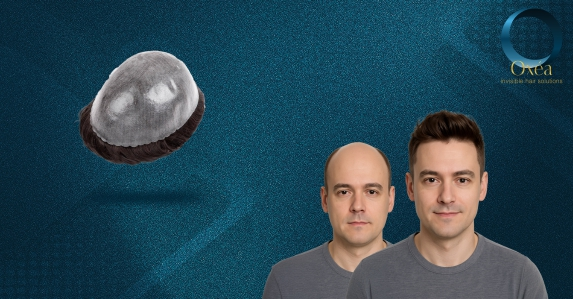



Contact our specialists now for Hair Replacement!
Considering the studies today around 6.5 million men and 8 million women experience noticeable hair thinning by their mid-thirties. Yet many remain uncertain about their specific hair loss pattern and which non surgical hair loss solution – toupee vs wig – best addresses their needs.
Before talking about toupee or wig, it is important to understand your specific hair loss pattern. Men typically experience androgenetic alopecia (male pattern baldness), whilst women face female pattern hair loss (or female androgenetic alopecia), each requiring different approaches.
Let’s consider a man who noticed his crown thinning whilst his hairline remained intact. His dermatologist identified classic vertex baldness – perfect for toupee coverage. Next, let us talk about a person whose hair loss progressed beyond his crown to affect his temples and entire top scalp – his trichologist confirmed advanced male pattern baldness, requiring a wig for complete coverage.
Your hair loss journey is unique – understanding your type of hair loss ensures you choose the most suitable solution between toupee vs wig confidently.
A toupee is a small hairpiece designed specifically to cover bald spots or thinning areas on your head. Unlike a full wig, it only covers the areas where you’ve lost hair.
A wig is a full head hair system. Unlike a toupee that covers specific bald spots, a wig provides full scalp coverage from front to back, offering a complete hair replacement solution for extensive hair loss.
Point of Difference
Toupee
Wig
Attachment
A toupee is typically attached directly to the scalp using adhesive or clips. This provides a more secure fit, often preferred by those looking for a solution that stays in place during various activities.
Wigs are typically worn over the head and do not require adhesive or tape. This makes them a non-invasive option that is easy to put on and take off without any additional tools or products.
Design
Toupees are often designed to cover only the balding area or specific patches of hair loss. They are smaller and more focused on blending with the remaining natural hair rather than covering the entire head.
Wigs are designed to cover the entire scalp. The design is structured to fit over the entire head, making it an ideal choice for those with significant hair loss or who want to completely change their hairstyle.
Maintenance
As the design of a toupee is smaller and adheres closely to the scalp, it requires regular maintenance, including cleaning and reapplying adhesive. Depending on the type of adhesive used, this can be a daily or weekly task.
Wigs require less frequent maintenance than toupees. Since they are worn over the whole head, they do not need to be attached daily and can be stored and cleaned less frequently.
Longevity
With proper care and maintenance, toupees can last several months. However, because they are typically smaller and more exposed to wear, they may need replacement sooner than wigs.
Wigs generally last longer than toupees, especially high-quality synthetic wigs or human hair wigs. With proper care, they can maintain their shape and appearance for a longer period.
Comfort
Toupees, especially those that are glued or taped, can feel lighter and less bulky compared to wigs. This makes them a comfortable choice for people who want to feel like they aren't wearing anything on their head.
Wigs tend to be bulkier and heavier than toupees, especially if they are made with dense materials. This can make them less comfortable, particularly during warmer weather or for individuals who are active..
Flexibility
Toupees offer more flexibility in terms of style and movement as they are usually tailored to a specific size and shape. Their close-fitting nature allows for more natural movement and better airflow to the scalp.
Wigs offer a high level of flexibility in terms of style, as they can be completely restyled to achieve different looks.
Discreetness
Due to their smaller size and more strategic placement, toupees are generally considered more discreet than wigs. They can blend in with existing hair more seamlessly.
Wigs having full coverage nature can be less discreet compared to toupees. Since they cover the entire head, they can sometimes appear bulkier, particularly if not properly fitted or styled.
Used for specific hair loss areas
Toupees are ideal for people who have localised bald spots, as they cover only the area of concern. They are often used for receding hairlines, crown baldness, or thinning areas.
Not like toupees, which are designed to cover specific bald patches or thinning areas, wigs are meant for full scalp coverage.
Secured Hair Replacement Option
They are fully secured because they are adhered directly to the scalp, toupees to stay in place better, making them ideal for active individuals..
While wigs are not as secure as toupees in terms of attachment, modern wigs come with adjustable straps and silicone linings to ensure they stay in place.
The age-old question of natural appearance often determines whether someone chooses a toupee or wig. Understanding the difference between toupee and wig in terms of realistic looks helps you make the right decision for your lifestyle.
Toupees are the best in natural appearance because they seamlessly set well with your existing hair while creating natural movement and flow.
You ask what the secret is and why it looks natural. It is because of its partial coverage – toupees don’t fight against your natural hair growth patterns. Instead, they complement what you already have, making detection nearly impossible when properly fitted.
Today’s wigs for women and men’s wig options have revolutionised natural appearance. Modern construction techniques, including hand-tied caps and realistic hairlines, have completely removed the stigma of the obvious “wig look” of previous decades.
Quality wigs now feature graduated hairlines, varied hair thickness, and natural scalp appearance that rivals your original hair. The key difference lies in complete replacement rather than integration.
Take our word – The most natural-looking choice is the one that suits your specific hair loss pattern and daily routine.
Neither a toupee nor a wig is universally “better” – the superior choice depends entirely on your specific hair loss pattern and coverage needs!
A toupee hairpiece works beautifully when you have bald spots like crown thinning or receding hairlines, as it integrates with your existing hair for natural movement and easier maintenance. However, wigs become a better option for extensive hair loss where partial coverage would look unnatural.
The debate of hair toppers vs hair wigs often centres on coverage area. If you can pinpoint specific bald spots and have healthy hair elsewhere, a toupee offers targeted precision and natural blending. Conversely, if your hair loss is widespread, diffuse, or affects multiple areas, a wig provides full head coverage that a toupee simply cannot match.
Talking about the Choice :
The difference between a toupee and a wig in natural appearance depends on your specific situation. If you have hair surrounding bald spots, toupees offer unmatched integration. For widespread hair loss, quality wigs provide complete natural coverage.
Consider your hair loss pattern, lifestyle, and maintenance preferences when weighing the pros and cons of toupees versus wigs. Both options, when properly selected and fitted, deliver one of the best results.
Once you have decided whether a toupee hair piece or wig better suits your hair loss pattern, proper application is the next thing you need to think about for achieving that natural look we discussed. Both toupees and wigs require secure attachment methods, with tape and glue being the most reliable options for ensuring your non surgical hair replacement stays in place throughout your day.
Point to consider – Wigs require more tape coverage for full scalp attachment.
No matter if it’s a toupee or wig, proper glue application ensures your hair replacement remains secure during exercise, swimming, or windy conditions, maintaining that natural appearance.
This is called temple hair loss, which is often a sign of androgenetic alopecia (male or female pattern baldness), which is primarily genetic.
Other factors include hormonal changes, high stress (telogen effluvium), nutritional deficiencies, or traction alopecia from tight hairstyles. A proper diagnosis from a professional can identify the exact cause.
The most common cause in both genders is genetic: male pattern baldness (forming an ‘M’ shape) or female pattern baldness (general thinning, sometimes affecting temples).
Early signs include noticing a general decrease in hair density around the temples, which can make the scalp more visible.
Natural regrowth is possible if the hair loss is caused by temporary factors like stress, diet deficiency, or tight hairstyles (traction alopecia).
If the cause is genetic (pattern baldness), natural methods like scalp massage and essential oils can support remaining hair, but medical treatments or transplants are typically needed for significant regrowth.
Still unsure whether a toupee or wig is the right choice for you?
Just book a consultation with us and let our experts at Oxea London do their job, where they will begin by guiding you through every step, from analysing your hair loss pattern to finding a solution that fits into your life (and budget).
During your consultation, we will provide real samples so you can feel the quality of our hair systems (wig & toupee), test different attachment methods, and even see how your chosen option looks in natural light.
Let’s find together the perfect balance between confidence, comfort, and style! See you on the other side.
Megan Brooks is a Certified Trichologist at Oxea Invisible Hair Solutions with over 21 years of Unbeatable experience. Throughout her remarkable career, she has successfully completed an impressive 8000+ hair replacement systems. Megan is dedicated to transforming lives and boosting self-confidence so that one can live with all the pride. She has served over 800 satisfied clients and still-counting, while helping them regain their natural appearance and feel their best.